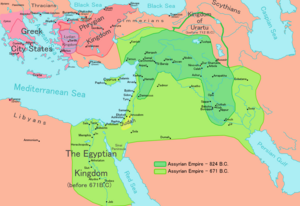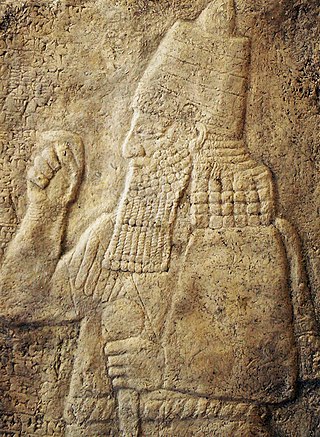
Sennacherib was the king of the Neo-Assyrian Empire from 705 BC until his assassination in 681 BC. The second king of the Sargonid dynasty, Sennacherib is one of the most famous Assyrian kings for the role he plays in the Hebrew Bible, which describes his campaign in the Levant. Other events of his reign include his destruction of the city of Babylon in 689 BC and his renovation and expansion of the last great Assyrian capital, Nineveh.

Tiglath-Pileser III was the king of the Neo-Assyrian Empire from 745 BC to his death in 727. One of the most prominent and historically significant Assyrian kings, Tiglath-Pileser ended a period of Assyrian stagnation, introduced numerous political and military reforms and more than doubled the lands under Assyrian control. Because of the massive expansion and centralization of Assyrian territory and establishment of a standing army, some researchers consider Tiglath-Pileser's reign to mark the true transition of Assyria into an empire. The reforms and methods of control introduced under Tiglath-Pileser laid the groundwork for policies enacted not only by later Assyrian kings but also by later empires for millennia after his death.
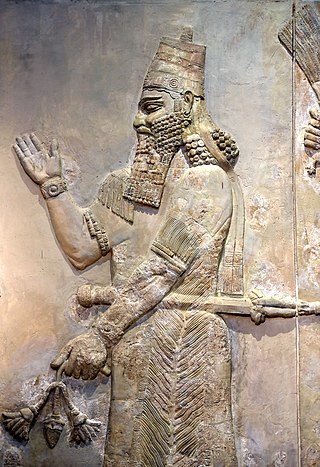
Sargon II was the king of the Neo-Assyrian Empire from 722 BC to his death in battle in 705. Probably the son of Tiglath-Pileser III, Sargon is generally believed to have become king after overthrowing Shalmaneser V, probably his brother. He is typically considered the founder of a new dynastic line, the Sargonid dynasty.
{{Infobox royalty|name=Shalmaneser V|title=

Tabal, later reorganised into Bīt-Burutaš or Bīt-Paruta, was a Luwian-speaking Syro-Hittite state which existed in southeastern Anatolia in the Iron Age.

Ravansar is a city in the Central District of Ravansar County, Kermanshah province, Iran, serving as capital of both the county and the district.
Aššur-rabi II, inscribed maš-šur-RA-bi, "(the god) Aššur is great," was king of Assyria 1012–972 BC. Despite his lengthy reign, one of the longest of the Assyrian monarchs, his tenure seems to have been an unhappy one judging by the scanty and laconic references to his setbacks from later sources.
Aššur-rēša-iši I, inscribed maš-šur-SAG-i-ši ruled 1132–1115 BC, son of Mutakkil-Nusku, was a king of Assyria, the 86th to appear on the Assyrian King List and ruled for 18 years. The Synchronistic King List and its fragmentary copies give him as a contemporary of the Babylonian kings Ninurta-nādin-šumi, Nebuchadnezzar I and Enlil-nādin-apli, although the last of these is unlikely per the commonly accepted chronology.

Simo Kaarlo Antero Parpola is a Finnish Assyriologist specializing in the Neo-Assyrian Empire and Professor emeritus of Assyriology at the University of Helsinki.

Erishum I or Erišu(m) Ic. 1974–1935 BCE, son of Ilu-shuma, was the thirty-third ruler of Assyria to appear on the Assyrian King List. He reigned for forty years. One of two copies of the Assyrian King List which include him gives his reign length as only 30 years, but this contrasts with a complete list of his limmu, some 40, which are extant from tablets recovered at Karum Kanesh. He had titled himself both as, "Ashur is king, Erishum is vice-regent" and the, “Išši’ak Aššur”ki, at a time when Assur was controlled by an oligarchy of the patriarchs of the prominent families and subject to the “judgment of the city”, or dīn alim. According to Veenhof, Erishum I’s reign marks the period when the institution of the annually appointed limmu (eponym) was introduced. The Assyrian King List observes of his immediate predecessors, “in all six kings known from bricks, whose limmu have not been marked/found”.

The Neo-Assyrian Empire was the fourth and penultimate stage of ancient Assyrian history. Beginning with the accession of Adad-nirari II in 911 BC, the Neo-Assyrian Empire grew to dominate the ancient Near East and parts of South Caucasus, North Africa and East Mediterranean throughout much of the 9th to 7th centuries BC, becoming the largest empire in history up to that point. Because of its geopolitical dominance and ideology based in world domination, the Neo-Assyrian Empire has been described as the first world empire in history. It influenced other empires of the ancient world culturally, administratively, and militarily, including the Neo-Babylonians, the Achaemenids, and the Seleucids. At its height, the empire was the strongest military power in the world and ruled over all of Mesopotamia, the Levant and Egypt, as well as parts of Anatolia, Arabia and modern-day Iran and Armenia.

Naram-Sin, or Narām-Sîn or –Suen, inscribed in cuneiform on contemporary seal impressions as dna-ra-am-dEN.ZU, had been the "waklum" or "Išši’ak Aššur" of the city-state Assur, listed as the 37th king of Assyria on the later Assyrian King Lists, where he is inscribed mna-ram-dEN.ZU, or a fragmentary list where he appears as -d30. He was named for the illustrious Naram-Sin of Akkad and took the divine determinative in his name Naram-Sin should not be confused with the Naram-Sin who had ruled Eshnunna for around twelve years It is probable that Naram-Sin of Assur was, however, contemporaneous with the earlier part of Ebiq-Adad II’s reign Naram-Sin of Assyria was the son and successor of the short-reigning Puzur-Ashur II, filiation preserved in his seal impression on the envelopes of the waklum-letters to his expat Anatolian-based traders at the karum Kanesh and in the later Assyrian King Lists.
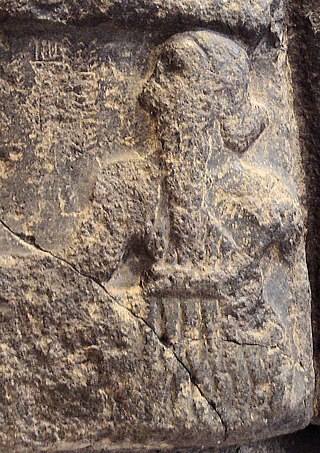
Sargon of Akkad, also known as Sargon the Great, was the first ruler of the Akkadian Empire, known for his conquests of the Sumerian city-states in the 24th to 23rd centuries BC. He is sometimes identified as the first person in recorded history to rule over an empire.

Khanileh is a village in Dowlatabad Rural District, in the Central District of Ravansar County, Kermanshah province, Iran. At the 2006 census, its existence was noted, but its population was not reported.
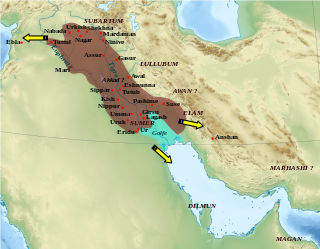
Akkad was the capital of the Akkadian Empire, which was the dominant political force in Mesopotamia during a period of about 150 years in the last third of the 3rd millennium BC.

The timeline of ancient Assyria can be broken down into three main eras: the Old Assyrian period, Middle Assyrian Empire, and Neo-Assyrian Empire. Modern scholars typically also recognize an Early period preceding the Old Assyrian period and a post-imperial period succeeding the Neo-Assyrian period.

The Sargonid dynasty was the final ruling dynasty of Assyria, ruling as kings of Assyria during the Neo-Assyrian Empire for just over a century from the ascent of Sargon II in 722 BC to the fall of Assyria in 609 BC. Although Assyria would ultimately fall during their rule, the Sargonid dynasty ruled the country during the apex of its power and Sargon II's three immediate successors Sennacherib, Esarhaddon and Ashurbanipal are generally regarded as three of the greatest Assyrian monarchs. Though the dynasty encompasses seven Assyrian kings, two vassal kings in Babylonia and numerous princes and princesses, the term Sargonids is sometimes used solely for Sennacherib, Esarhaddon and Ashurbanipal.

Akkadian or Mesopotamian royal titulary refers to the royal titles and epithets assumed by monarchs in Ancient Mesopotamia from the Akkadian period to the fall of the Neo-Babylonian Empire, with some scant usage in the later Achaemenid and Seleucid periods. The titles and the order they were presented in varied from king to king, with similarities between kings usually being because of a king's explicit choice to align himself with a predecessor. Some titles, like the Akkadian šar kibrāt erbetti and šar kiššatim and the Neo-Sumerian šar māt Šumeri u Akkadi would remain in use for more than a thousand years through several different empires and others were only used by a single king.

Ishtar of Arbela or the Lady of Arbela was a prominent goddess of the Neo-Assyrian Empire. She was the tutelary goddess of the city of Arbela as well as a patron goddess of the king. She was clearly distinct from other 'Ishtar' goddesses in religious worship. For example, in the city of Assur, she had a shrine separate from Ishtar of Assur, and Ishtar of Nineveh had a separate cult from either deity in Assur as well as a presence in Arbela. Similarly, they are usually distinguished from each other in hymns, prophetic texts, and treaties. In his Hymn to the Ištars of Nineveh and Arbela, King Ashurbanipal refers to the pair as 'my Ishtars' and uses plural language throughout, as well as ascribing them different functions in supporting the king. However, some poetic and prophetic texts appear to not draw sharp lines between their identities and refer to an unspecified "Ishtar".
